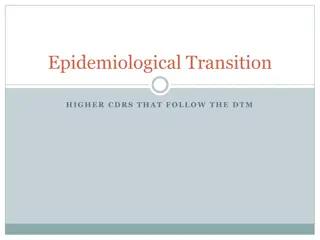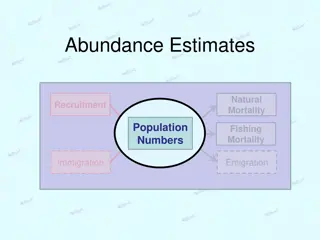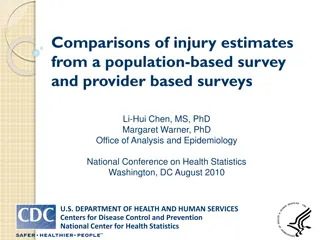Low Pay Household Estimates in Rural India
Analysis of data from the Periodic Labour Force Survey reveals estimates of households with monthly per capita earnings below a threshold in Rural India. The study, presented by Vasavi Bhatt, focuses on the characteristics of low earnings households and highlights the importance of decent work and i
1 views • 8 slides
Guide to Updating AEM & Spectrum for 2021 Estimates
Discover the essential steps to update AEM and Spectrum for 2021 estimates. Learn how to download and install the latest versions, set up AEM5, import and update files, compare outputs, and utilize the provided country package to kickstart your AEM5 journey.
7 views • 27 slides
Temporary Storage Facility Design Concept Overview
Technical presentation on the design concept of a Consolidated Interim Storage Facility for spent nuclear fuel and high-level radioactive waste. The concept includes a reference design, independent cost estimates, and site plan details for potential host communities. The design features cask-on-a-pa
0 views • 21 slides
Colorado State Epidemiological Profiles - Substance Abuse Trends & Response Task Force
The Colorado State Epidemiological Profiles provide a state-level overview of data from various surveillance sources for prevention, intervention planning, monitoring, and evaluation. The profiles cover demographics, alcohol, marijuana, opioids, sustainability, and next steps. Updated every 2 years,
0 views • 12 slides
Understanding the Epidemiological Transition Stages
The Epidemiological Transition model explains shifts in causes of death at different stages of demographic transition. From pestilence and famine to delayed degenerative diseases, each stage highlights key factors influencing mortality patterns. By recognizing these transitions, healthcare professio
0 views • 8 slides
Understanding Epidemiological Profiles in Public Health Practice
Epidemiological profiles play a crucial role in substance abuse and mental health planning, helping professionals prioritize issues and raise awareness. The profiles include quantitative and qualitative data to analyze behavioral risk factors, consumption patterns, and clinical outcomes, sourced fro
1 views • 13 slides
FDA Perspective on Epidemiological Cut-off Values (ECVs)
The FDA presents insights on the development and use of Epidemiological Cut-off Values (ECVs) to distinguish wild-type populations from those with acquired resistance mechanisms. ECVs are crucial for determining antimicrobial susceptibility and guiding treatment decisions. The process involves analy
0 views • 13 slides
Understanding Epidemiological Study Designs and Measures of Risks
This informative content covers various epidemiological study designs, including observational and experimental studies, clinical trials, cohort studies, and more. It explains the concept of cohorts, indications for cohort studies, and the design considerations involved. Images are included to illus
6 views • 41 slides
Understanding Association and Causation in Epidemiological Studies
Exploring the concepts of association and causation in epidemiological studies, this content delves into the complexities of determining if exposure leads to disease risk. It discusses different types of associations, such as spurious, indirect, and direct causal associations, illustrating the chall
5 views • 43 slides
Types of Bias in Epidemiological Studies
Bias in epidemiological studies can arise from misclassification of observations and exposures, leading to incorrect associations between variables. Observation bias, misclassification bias, and non-differential misclassification can impact the accuracy of study results, either minimizing difference
1 views • 11 slides
Overview of Epidemiological Cutoff Values (ECVs) in Antimicrobial Susceptibility Testing
Epidemiological Cutoff Values (ECVs) are crucial in determining antimicrobial susceptibility by distinguishing wild-type and non-wild-type microbial populations. ECVs are defined based on factors like minimal inhibitory concentration (MIC) and genetic variation, and are determined through specific m
0 views • 16 slides
Understanding Inverse Probability Weights in Epidemiological Analyses
In epidemiological analyses, inverse probability weights play a crucial role in addressing issues such as sampling, confounding, missingness, and censoring. By reshaping the data through up-weighting or down-weighting observations based on probabilities, biases can be mitigated effectively. Differen
0 views • 25 slides
Understanding Directed Acyclic Graphs (DAGs) for Causal Inference
Directed Acyclic Graphs (DAGs) play a crucial role in documenting causal assumptions and guiding variable selection in epidemiological models. They inform us about causal relationships between variables and help answer complex questions related to causality. DAGs must meet specific requirements like
1 views • 63 slides
Overview of Occupational Requirements Survey (ORS) and 2020 Estimates
The Occupational Requirements Survey (ORS) by the Bureau of Labor Statistics provides detailed insights into the occupational demands of various job roles, including physical, cognitive, and environmental requirements. The survey encompasses data on speaking requirements, weight lifting capabilities
0 views • 22 slides
Statewide Epidemiological Outcomes Workgroup Quarterly Meeting Overview
This overview captures the key discussions of the Statewide Epidemiological Outcomes Workgroup Quarterly Meeting. Topics included the NSDUH, Monitoring the Future survey, Youth Risk Behavioral Surveillance Survey, Arkansas Department of Human Services Annual Report, and Crime Information Center data
1 views • 9 slides
Maryland Revenue Estimates & Economic Outlook March 2022
The revenue estimates and economic outlook for Maryland in March 2022 show growth in income taxes, sales and use taxes, and other revenues. Detailed figures for fiscal years 2021-2023 indicate estimates and actual data for various tax types like individual and corporate income taxes. The changes in
0 views • 17 slides
Enhancing Pesticide Exposure Assessment for Epidemiological Studies
Focuses on IMPRESS project aiming to improve methodologies for assessing occupational pesticide exposure in epidemiological studies. Reviews challenges in retrospective exposure assessment, proposes methodologies, and presents key project results to date, emphasizing the use of various exposure asse
1 views • 15 slides
Analyzing Deepwater Disaster: Inaccurate Oil Spill Estimates
Explore the Deepwater Horizon disaster, where oil spill estimates were inaccurate due to various factors such as convoluted discharges, technological limitations, and reluctance to share data. Consequences of underestimation and reasons behind flawed estimates are discussed, shedding light on the ch
0 views • 13 slides
EMS-Administered Naloxone and Patient Outcomes in Hawaii: Epidemiological Study
This study presents findings from a linked dataset analyzing EMS-administered naloxone and patient outcomes in Hawaii from 2012-2016. Part 1 covers basic epidemiological descriptions and linkage to hospital billing data, while Part 2 investigates associations between EMS response times and patient o
0 views • 14 slides
Provisional Gross Domestic Product (GDP) Estimates Presentation April 11, 2018
The release provides provisional GDP estimates for the fourth quarter of 2017, along with revised estimates for the first three quarters of 2017 and annual estimates for 2016. The GDP measures the value of goods and services produced in the country. The estimation of GDP is done in stages, with prov
0 views • 33 slides
Prescription Drug and Opioid Misuse in Illinois Epidemiological Profile
Explore the Illinois Statewide Epidemiological Profile on Prescription Drug and Opioid Misuse, developed by the Illinois Statewide Epidemiological Outcomes Workgroup and funded by Substance Abuse and Mental Health Services Administration. The profile covers consumption, prevalence, contributing fact
0 views • 28 slides
Guidelines for Acceptable Estimates in Online Applications
Examples of acceptable and non-acceptable estimates in online applications for infrastructure projects. Criteria include clear itemization, exclusion of unnecessary fees, proper documentation of road names, and accurate unit measurements to avoid common errors. These guidelines help ensure accuracy
0 views • 7 slides
GAO Cost and Schedule Assessment Guides: Enhancing Government Accountability
The Government Accountability Office (GAO) plays a crucial role in supporting Congress to fulfill its responsibilities by improving federal government performance and ensuring accountability. The GAO Cost Estimating and Assessment Guide outlines criteria for assessing cost estimates, and the Reliabl
0 views • 19 slides
Best Practices for Contractors: Examples of Acceptable and Non-Acceptable Estimates and Bids
Explore examples of acceptable and non-acceptable estimates and bids for contractors in online applications. Learn why lump sum estimates, lack of detailed information, and incorrect unit bidding can impact the bidding process negatively. Discover how clarity, itemization, and adherence to bidding s
0 views • 13 slides
Fisheries Abundance Estimates and Depletion Methods
Explore common abundance estimation techniques like CPUE, mark-recapture, and depletion methods. Understand how to calculate relative density, depletion estimates, and cumulative catch. Discover the concepts of N0, Nt, Ct, and q in depletion estimates using regression models. Learn about the assumpt
0 views • 10 slides
Understanding Multiyear Estimates from the American Community Survey
This comprehensive guide delves into the concept of multiyear estimates from the American Community Survey (ACS). It explains what multiyear estimates are, when to use them, considerations to keep in mind, making comparisons with them, examples of their application, definitions of period and multiye
0 views • 35 slides
Understanding Abundance Estimates in Fisheries Management
Explore the concept of abundance estimates in fisheries management, including natural mortality, recruitment, population numbers, fishing mortality, immigration, and emigration. Learn about common abundance estimation methods like CPE/CPUE, depletion/removal estimates, and mark-recapture techniques.
0 views • 10 slides
Postharvest Loss Estimates for Cereals and Crops: A Practical Guide
Explore APHLIS website to access science-based estimates of postharvest losses for cereals and crops using an interactive calculator tool in Excel. Discover how to input location-specific data, select crop and climate zones, and obtain quality estimates for different harvest seasons. The APHLIS Calc
0 views • 38 slides
Lake Washington PCB/PBDE Study Estimates and Loading Pathways
This study presents estimates of loading of PCB/PBDE pollutants in Lake Washington from major pathways, including rivers, local drainages, and monitored tributaries. The data shows current PCB loading estimates to Lake Washington and its exits to Puget Sound, providing insights into sources and conc
0 views • 12 slides
Support Structure Fabrication Project Overview
An overview of a support structure fabrication project by Hanzel, focusing on procurement strategy, budgetary estimates, vendor quotes, and lead times for various components like yokes, loadpads, collars, master and false coils, aluminum shells, nitronic end plates, axial rods, and tension rods. The
0 views • 13 slides
A Comparison of Injury Estimates from Population-Based and Provider-Based Surveys
This study compares injury estimates obtained from a population-based health survey with estimates from two provider-based surveys. Data from the National Health Interview Survey (NHIS), National Hospital Ambulatory Medical Care Survey (NHAMCS-ED), and National Hospital Discharge Survey (NHDS) are a
0 views • 18 slides
Formulation of Research Questions, Objectives, and Hypotheses in Epidemiological Studies
Explore the importance of defining research questions, objectives, and hypotheses in epidemiological research, illustrated through examples from studies on diabetes mellitus in Saudi Arabia. Understand the steps involved in crafting clear objectives and hypotheses to address public health challenges
0 views • 37 slides
Understanding Epidemiological Studies and Their Importance in Public Health
Epidemiological studies are crucial in understanding the distribution and determinants of health events in populations. They encompass various types, such as descriptive and analytical epidemiology, focusing on factors contributing to diseases. Epidemiologists use statistical methods to study health
0 views • 14 slides
Insights from India Maize Summit 2013: Market Trends and Production Estimates
Discover key highlights from the India Maize Summit 2013 in New Delhi, showcasing global maize market trends, production estimates, export destinations, challenges, and India's role in international trade. Explore data on maize production, trade, consumption, and stocks globally and in India, along
0 views • 13 slides
Understanding Epidemiological Terms in Public Health
Epidemiological terms such as infection, infestation, infectivity, infectiousness, and more are important in understanding the spread and control of diseases. This detailed guide by Faisal Muhammad covers key concepts in public health, including definitions, examples, and the importance of terms lik
0 views • 34 slides
Assessment of Epidemiological Capacity in 27 Big Cities: Key Findings and Implications
Delve into the recent assessment of epidemiological capacity in 27 major cities, with insights from experts Jessica Arrazola, Chrissie Juliano, and Meghan McGinty. Explore the objectives, results, and unique aspects of the assessment, shedding light on strategies to enhance public health service del
0 views • 46 slides
Enhanced Flow Estimates in NHDPlus Version 02 Presentation
Presentation by Tim Bondelid at the ESRI International User Conference discussing the Enhanced Runoff Method (EROM) in NHDPlus Version 02 for improved stream flow estimates. Highlights the importance of accurate flow estimates for various water-related goals and the methodology used to enhance flow
0 views • 18 slides
Colorado Epidemiological Profiles 2021 - Substance Use Data and Analysis
The 2021 Colorado Epidemiological Profiles provide in-depth data and analysis on substance use patterns, impacts, and demographics in Colorado. The profiles cover alcohol, marijuana, opioids, and tobacco, along with special considerations for populations like LGBTQ, veterans, tribal communities, unh
0 views • 19 slides
Understanding Confidence Intervals and Point Estimates in Statistics
Explore how confidence intervals are constructed around point estimates such as sample mean in statistics. Learn the significance of confidence levels and how to develop confidence intervals using practical examples. Follow step-by-step instructions to analyze data and interpret results for populati
0 views • 20 slides
Model-Based Early Estimates for Health Statistics Enhancement
The National Center for Health Statistics (NCHS) is working on improving the timeliness and granularity of data through model-based early estimates. Their goal is to enable data-driven actions, predict deaths, and report data accurately. The NCHS is focusing on enhancing their data systems and produ
0 views • 6 slides







































